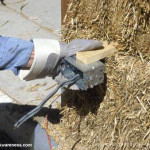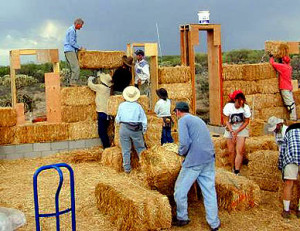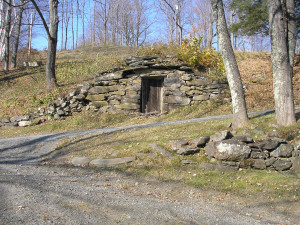 Root cellar is a wonderful structure used to store food, vegetable, root vegetable, and fruits. Structure can by built underground, partially underground or above ground, but very well insulated. Purpose of root cellar is to keeping the temperature and humidity in stable range.
Root cellar is a wonderful structure used to store food, vegetable, root vegetable, and fruits. Structure can by built underground, partially underground or above ground, but very well insulated. Purpose of root cellar is to keeping the temperature and humidity in stable range.
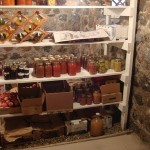 Cold storage of fruits and vegetables was used extensively by our ancestors to keep food after the harvest season. People used root cellars to store besides the vegetable, and fruits, vine, caned food, home made alcoholic beverages, salt meat, smoked bacon, and fish. In modern times, the year round availability of fresh produce in the supermarket has reduced the use of home storage. However, even today there are benefits of home storage, which make it a good alternative to buying produce from the store. Most importantly, home gardeners often have excess fruits and vegetables that cannot be consumed immediately but would store well. Even those without gardens can buy food ‘in season’ when it is fresh and inexpensive and then store it at home until a later date. Both these options are cheaper than buying food in the winter when it is often quite expensive. In addition, stored food harvested at peak maturity from the garden usually has better flavor and a higher nutritional value.
Cold storage of fruits and vegetables was used extensively by our ancestors to keep food after the harvest season. People used root cellars to store besides the vegetable, and fruits, vine, caned food, home made alcoholic beverages, salt meat, smoked bacon, and fish. In modern times, the year round availability of fresh produce in the supermarket has reduced the use of home storage. However, even today there are benefits of home storage, which make it a good alternative to buying produce from the store. Most importantly, home gardeners often have excess fruits and vegetables that cannot be consumed immediately but would store well. Even those without gardens can buy food ‘in season’ when it is fresh and inexpensive and then store it at home until a later date. Both these options are cheaper than buying food in the winter when it is often quite expensive. In addition, stored food harvested at peak maturity from the garden usually has better flavor and a higher nutritional value.
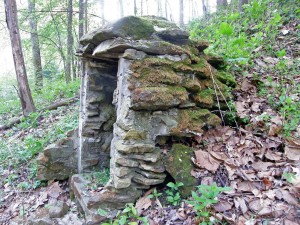 When harvesting your own produce for storage, or buying it locally in season, there are certain guidelines to follow which assure
When harvesting your own produce for storage, or buying it locally in season, there are certain guidelines to follow which assure
maximum quality and minimum spoilage of your stored food.
- Harvest fruits and vegetables at peak maturity or as near as possible.
- Only use produce that is free from all visible evidence of disease.
- Do not pick any fruit or vegetable that has severe insect damage.
- Handle food carefully after harvest so that it is not cut or bruised.
- Leave an inch or more of stem on most vegetables to reduce water loss and prevent infection.
- Use late-maturing varieties better suited to storage.
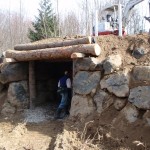 In general, use only the best food for storage. Damaged food is more likely to suffer mold and bacterial decay during storage and
In general, use only the best food for storage. Damaged food is more likely to suffer mold and bacterial decay during storage and
thus should be used fresh, processed, or discarded.
Once harvested, fruits and vegetables must be stored under proper conditions, the most important
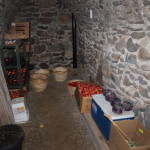
of which are temperature and
humidity. Each fruit or vegetable has its own ideal set of conditions at which it will store most successfully for the maximum length of time. These conditions can be classified into four groups:
- Vegetables which require cold & moist conditions
- Vegetables which require cool & moist conditions
- Vegetables which require cold & dry conditions
- Vegetables which require warm & dry conditions
The tables on the following list temperature and humidity requirements for most vegetables. In addition to proper
temperature and humidity, all fruits and vegetables must be kept in a dark, aerated environment. While most vegetables like moist
conditions, standing water must be avoided, as it will quickly lead 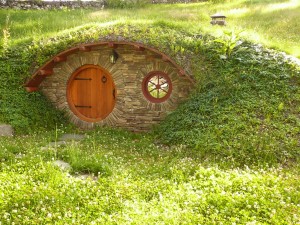 to rot. Produce must not be allowed to freeze and should be protected from animal pests such as mice. It is important to remember that crops held in storage are still living plants, capable of respiration and affected by their environment. The goal of
to rot. Produce must not be allowed to freeze and should be protected from animal pests such as mice. It is important to remember that crops held in storage are still living plants, capable of respiration and affected by their environment. The goal of
storage is to keep them in a dormant state.
*One other note, fruits and vegetables should always be stored separately. Fruits release ethylene, which speeds the ripening process of vegetables. Fruits are also very susceptible to
picking up the taste of nearby vegetables.
| Fruits & Vegetable that require cold, moist conditions | ||||
| Name | Temperature (`C} | Humidity (%) | Lenfh of storage | |
| Asparagus | 0-2 | 95 | 2-3 w | |
| Apples | 0 | 90 | 2-6 m | |
| Beets | 0 | 95 | 3-5 m | |
| Broccoli | 0 | 95 | 10-14 d | |
| Brussels Srouts | 0 | 95 | 3-5 w | |
| Cabbage, Early | 0 | 95 | 3-6 w | |
| Cabbage, Late | 0 | 95 | 3-4 m | |
| Cabbage, Chinese | 0 | 95 | 1-2 m | |
| Carots, mature | 0 | 95 | 4-5 m | |
| Canots, immature | 0 | 95 | 4-6 w | |
| Cauliflower | 0 | 95 | 2-4 w | |
| Celeriac | 0 | 95 | 3-4 m | |
| Celery | 0 | 95 | 2-3 m | |
| Collards | 0 | 95 | 10-14 d | |
| Corn, sweet | 0 | 95 | 4-8 d | |
| Endive, Escarole | 0 | 95 | 2-3 w | |
| Grapes | 0 | 90 | 4-6 w | |
| Kale | 0 | 95 | 10-14 d | |
| Leeks, green | 0 | 95 | 1-3 m | |
| Lettuce | 0 | 95 | 2-3 w | |
| Parsley | 0 | 95 | 1-2 m | |
| Parsnips | 0 | 95 | 2-6 m | |
| Pears | 0 | 95 | 2-7 m | |
| Peas. green | 0 | 95 | 1-3 w | |
| Potatoes, early | 10 | 90 | 1-3 w | |
| Potatoes, late | 4 | 90 | 4-9 m | |
| Radishes, spring | 0 | 95 | 3-4 w | |
| Radishes, winter | 0 | 95 | 2-4 m | |
| Rhubarib | 0 | 95 | 2-4 w | |
| Rutabagas | 0 | 95 | 2-4 m | |
| Spinach | 0 | 95 | 10-14 d | |
| Vegetabtes that require cool, moist conditions | ||||
| Name | Temperature (`C} | Humidity (%) | Lenfh of storage | |
| Bears. snap | 4-10 | 95 | 7-10 d | |
| Cucumbers | 7-10 | 95 | 10-14 d | |
| Eggplaat | 7-10 | 90 | 1 w | |
| Cantaloupe | 4 | 90 | 15 d | |
| Watermelon | 4-10 | 80-85 | 2-3 w | |
| Peppers sweet | 7-10 | 95 | 2-3 w | |
| Potatoes, early | 10 | 90 | 1-3 w | |
| Potatoes, late | 4 | 90 | 4-9 m | |
| Tomatoes, green | 10-21 | 90 | 1-3 w | |
| Tomatoes, ripe | 7-10 | 90 | 4-7 d | |
| Vegetables that require cool, dry conditions | ||||
| Name | Temperature (`C} | Humidity (%) | Lenfh of storage | |
| Garlic, onion | 0 | 65-70 | 6-7 m | |
| Vegetables that require warm dry conditions | ||||
| Name | Temperature (`C} | Humidity (%) | Lenfh of storage | |
| Peppers, hot | 10 | 60-65 | 6 m | |
| Pumpkins | 10-15 | 70-75 | 2-3 m | |
| Squash, winnter | 10-15 | 50-60 | 2-6 m | |
| Sweet Potato | 13- 15 | 80-85 | 4-6 m | |
Would you like to build your own root cellar? Here is my step by step video. If you have any question don’t hesitate to ask.

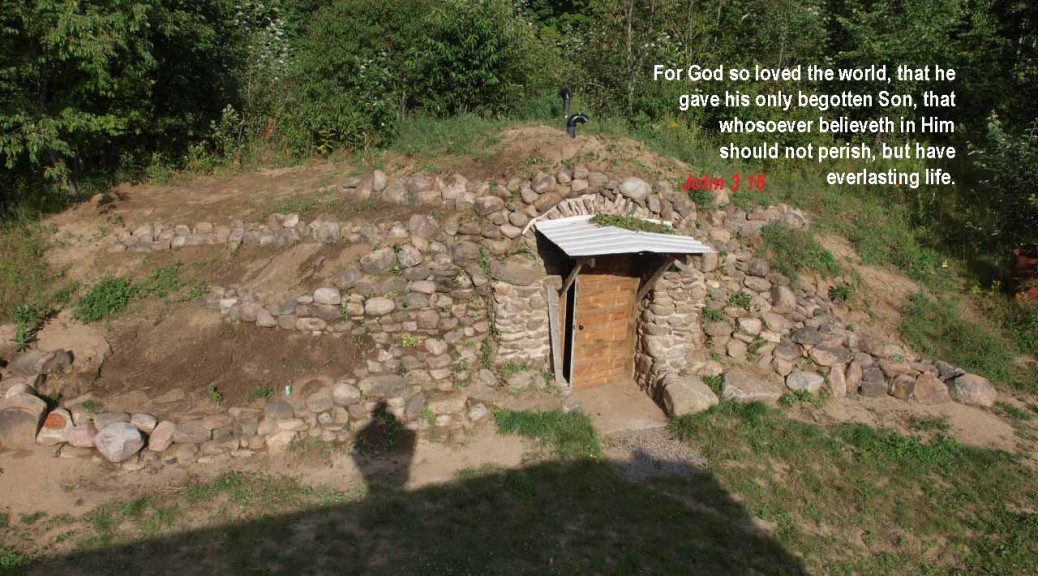
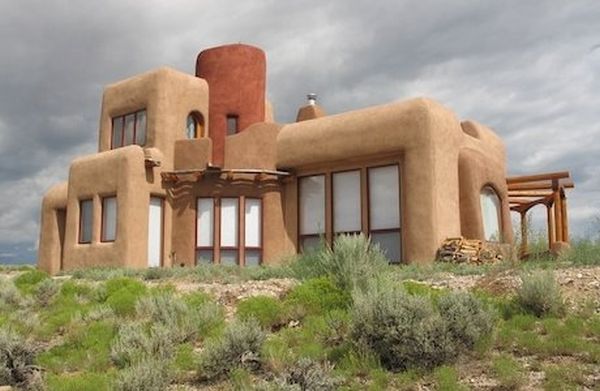
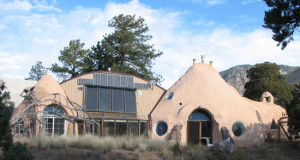 Straw bales were a fairly common building material in the world between 18
Straw bales were a fairly common building material in the world between 18
